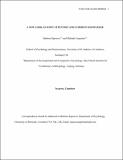Files in this item
A new look at joint attention and common knowledge
Item metadata
| dc.contributor.author | Siposova, Barbora | |
| dc.contributor.author | Carpenter, Malinda | |
| dc.date.accessioned | 2020-04-19T23:32:12Z | |
| dc.date.available | 2020-04-19T23:32:12Z | |
| dc.date.issued | 2019-08 | |
| dc.identifier | 258686813 | |
| dc.identifier | e57476c6-5d8d-4355-9023-a3a54c148dad | |
| dc.identifier | 85064467592 | |
| dc.identifier | 000472693900024 | |
| dc.identifier.citation | Siposova , B & Carpenter , M 2019 , ' A new look at joint attention and common knowledge ' , Cognition , vol. 189 , pp. 260-274 . https://doi.org/10.1016/j.cognition.2019.03.019 | en |
| dc.identifier.issn | 0010-0277 | |
| dc.identifier.other | ORCID: /0000-0003-3983-2034/work/64697970 | |
| dc.identifier.uri | https://hdl.handle.net/10023/19824 | |
| dc.description.abstract | Everyone agrees that joint attention is a key feature of human social cognition. Yet, despite over 40 years of work and hundreds of publications on this topic, there is still surprisingly little agreement on what exactly joint attention is, and how the jointness in it is achieved. Part of the problem, we propose, is that joint attention is not a single process, but rather it includes a cluster of different cognitive skills and processes, and different researchers focus on different aspects of it. A similar problem applies to common knowledge. Here we present a new approach: We outline a typology of social attention levels which are currently all referred to in the literature as joint attention (from monitoring to common, mutual, and shared attention), along with corresponding levels of common knowledge. We consider cognitive, behavioral, and phenomenological aspects of the different levels as well as their different functions, and a key distinction we make in all of this is second-personal vs. third-personal relations. While we focus mainly on joint attention and common knowledge, we also briefly discuss how these levels might apply to other ‘joint’ mental states such as joint goals. | |
| dc.format.extent | 15 | |
| dc.format.extent | 1112500 | |
| dc.language.iso | eng | |
| dc.relation.ispartof | Cognition | en |
| dc.subject | Joint attention | en |
| dc.subject | Common knowledge | en |
| dc.subject | Second-person relations | en |
| dc.subject | Communication | en |
| dc.subject | Joint action | en |
| dc.subject | Commitments | en |
| dc.subject | BF Psychology | en |
| dc.subject | T-NDAS | en |
| dc.subject.lcc | BF | en |
| dc.title | A new look at joint attention and common knowledge | en |
| dc.type | Journal article | en |
| dc.contributor.institution | University of St Andrews. Centre for Research into Equality, Diversity & Inclusion | en |
| dc.contributor.institution | University of St Andrews. Centre for Social Learning & Cognitive Evolution | en |
| dc.contributor.institution | University of St Andrews. School of Psychology and Neuroscience | en |
| dc.identifier.doi | https://doi.org/10.1016/j.cognition.2019.03.019 | |
| dc.description.status | Peer reviewed | en |
| dc.date.embargoedUntil | 2020-04-20 |
This item appears in the following Collection(s)
Items in the St Andrews Research Repository are protected by copyright, with all rights reserved, unless otherwise indicated.

